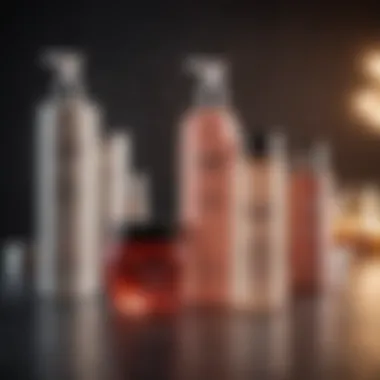Ultimate Guide to Hair Care After Bleaching


Intro
Bleaching hair is a transformative process that can dramatically change one’s appearance. However, the consequences of this alteration are significant. Most often, individuals desire to achieve blonde or lighter hair shades, yet fail to recognize the critical need for proper post-bleach care.
Maintaining hair health after bleaching is not merely an optional step; it is essential for preserving the quality and integrity of hair. Bleaching strips the hair of its natural moisture and oils, potentially leading to dryness and breakage. This prompts the necessity for a comprehensive regimen that encompasses various strategies to revive and nourish the hair post-treatment.
This article serves as an in-depth guide, aimed at enlightening readers on effective ways to care for bleached hair. From selecting suitable products to implementing effective treatment routines, every aspect will be explored diligently. Understanding these elements can ensure that bleached hair remains not only vibrant, but also healthy.
Understanding the Effects of Bleaching
Bleaching hair is a popular process for achieving lighter shades, yet it is crucial to understand its effects. The transformation can be striking, but the process comes with challenges that affect hair’s health. Understanding these effects can help in managing not just the look of the hair, but also its overall integrity and resilience.
Chemical Impact on Hair Structure
Bleaching works due to chemicals that break down the natural pigments in hair. It typically involves hydrogen peroxide or ammonia, which can lift color by damaging the outer layer of the hair shaft, known as the cuticle. This disruption allows the bleaching agents to penetrate deeper and lighten the hair.
As a result, the hair structure becomes more porous and fragile. This transformation can lead to hairs that feel rough and dry. It is essential to use products that are specifically formulated to counteract this damage. Regular deep conditioning treatments can help replenish moisture and restore some integrity to bleached hair. Awareness of these chemical impacts is the first step toward effective recovery and maintenance of bleached hair.
Common Consequences of Bleaching
The consequences of bleaching hair vary among individuals but tend to share common traits.
- Dryness and Brittleness: Bleached hair often loses its natural moisture, leaving strands dry and brittle. This can lead to split ends and breakage.
- Color Fading: Without proper care, the vibrant color achieved through bleaching can dull and fade quickly. This means more frequent touch-ups are necessary, which can compound the damage.
- Increased Frizz: The disruption of the hair cuticle makes it more prone to frizz. Humidity can exacerbate the problem, making the hair appear unmanageable.
- Scalp Sensitivity: Some individuals might experience scalp irritation or sensitization following bleaching. This can lead to discomfort and requires careful product selection to soothe the scalp.
It is vital to embrace awareness of these consequences to follow a targeted hair care routine that mitigates damage and maintains quality.
Recognizing these common issues allows individuals to make informed choices about their hair care products and routines, aligning with their desired aesthetic yet prioritizing health.
Immediate Post-Bleach Care
Immediate post-bleach care is critical in preserving the health and appearance of bleached hair. The bleaching process, while effective for changing hair color, can lead to significant damage if not followed by appropriate care. Bleached hair can become dry, brittle, and prone to breakage. Therefore, a strategic approach during the early stages after bleaching can mitigate potential harms. By focusing on hydration, gentle cleansing, and avoiding damaging practices, individuals can set a strong foundation for ongoing hair health.
First Wash: What You Need to Know
The first wash after bleaching is paramount. It is advisable to wait at least 48 hours before washing to allow the hair cuticles to close properly after treatment. This wait helps lock in the vibrancy of the new color while minimizing moisture loss. When it’s time to wash, using lukewarm water is ideal. Hot water can exacerbate dryness, whereas cold water may not effectively cleanse the scalp or hair.
Using a gentle, sulfate-free shampoo minimizes further stripping of natural oils. Many individuals may feel tempted to apply a strong cleansing agent to remove potential residue from bleach; however, this approach often leads to increased damage. Instead, a softer touch respects the delicate state of freshly bleached hair.
Avoiding Heat and Styling Tools Initially
After bleaching, it is critical to avoid applying any heat or styling tools initially. Hair that has undergone bleach treatment is already compromised and sensitive. Using flat irons, curling wands, or even hairdryers can result in further damage, exacerbating dryness, and increasing the risk of breakage.
A safe alternative is to allow hair to air-dry naturally. Embracing natural textures during this period fosters recovery and strengthens hair fibers. Additionally, when heat styling is reintroduced, selecting a lower heat setting can help reduce damage in the long term.
Opting for Sulfate-Free Shampoos
Choosing sulfate-free shampoos is essential for the care of bleached hair. Sulfates, primarily used for their cleansing properties, can be overly harsh on hair that has been altered chemically. These ingredients may strip away necessary oils, leading to dryness and dullness.
Sulfate-free alternatives are generally gentler, providing adequate cleansing without compromising moisture. Such shampoos often include nourishing ingredients, like aloe vera or coconut oil, that support hydration. Regularly incorporating these products into the washing routine not only protects the hair but also contributes to its overall health and resilience.
Key Takeaway: The post-bleaching period is crucial. By delaying the first wash, avoiding heat, and selecting sulfate-free products, individuals can protect and enhance the longevity of their hair's new color.
Hydration and Moisture Retention
Proper hydration and moisture retention are critical for maintaining the health of bleached hair. The bleaching process strips the hair of its natural moisture, rendering it dry and prone to damage. Therefore, replenishing moisture becomes essential to restore shine and strength.
When your hair has sufficient hydration, it appears softer and healthier. Hydrated hair is also better at resisting breakage and split ends, which are common issues for bleached strands. Implementing a rigorous hydration routine not only addresses immediate dryness but also contributes to the long-term vitality of your hair. It is worth mentioning that moisture retention involves choosing the right products and treatment methods that cater specifically to bleached hair. This becomes particularly relevant for individuals transitioning from dark to light shades, as the modification in hair structure requires careful attention to hydration.


Importance of Conditioning Treatments
Conditioning treatments play a pivotal role in reintroducing moisture to bleached hair. After undergoing chemical treatments like bleaching, hair often loses its elasticity and becomes brittle. Conditioners work by coating the hair strands with essential nutrients and minerals that aid in restoration. Deep conditioning treatments, in particular, penetrate the hair shaft, offering intensive moisture and helping to rebuild the hair’s internal structure.
Regular use of conditioners not only keeps the hair hydrated but also improves its overall texture and manageability. Hair that is well-conditioned is less susceptible to environmental stressors, thus promoting a healthier appearance over time.
Leave-In Conditioners: An Overview
Leave-in conditioners have become an integral part of post-bleaching care. These are lightweight formulations designed to be applied after washing but not rinsed out. Their purpose is to provide continuous moisture throughout the day, working as a protective layer against external factors.
Such products can ease styling and reduce tangles, which is particularly beneficial for bleached hair that can be prone to knots. Furthermore, they can offer additional benefits, such as UV protection and thermal defense, which are crucial for maintaining hair health.
Natural Oils for Hydration
Natural oils are often lauded for their moisturizing properties. They can provide extra hydration, seal moisture, and add gloss to the hair. Here are the three popular choices:
Coconut Oil
Coconut oil is widely recognized for its ability to penetrate the hair shaft. Its unique molecular structure allows for deep absorption, which is a significant advantage for bleached hair that requires thorough hydration. Because of its composition, coconut oil helps reduce protein loss, keeping hair healthier over time. Moreover, it has antimicrobial properties, which can help with scalp health. However, it is essential to use it in moderation to avoid weighing the hair down.
Argan Oil
Argan oil is often referred to as "liquid gold" due to its rich nutrient profile. Packed with vitamin E and fatty acids, it nourishes bleached hair and combats frizz. Additionally, it enhances shine by creating a natural barrier on the hair’s surface, locking in moisture effectively. While it is a beneficial oil for many, those with fine hair should use it sparingly to prevent heaviness and greasiness.
Jojoba Oil
Jojoba oil closely resembles the natural sebum produced by the scalp, making it an excellent choice for hydration. It moisturizes without leaving the hair feeling greasy, making it suitable for all hair types. Additionally, it helps to balance oil production on the scalp, which can be beneficial for those who experience dryness due to bleaching. However, some may find it less effective in providing deep hydration compared to oils like coconut.
"Choosing the right natural oil can make a tangible difference in how your bleached hair looks and feels."
Nourishment and Repair
After undergoing the bleaching process, one of the most critical aspects of maintaining healthy hair is nourishment and repair. Bleaching strips hair of its natural moisture and proteins, leaving it prone to damage. The right care can restore hair vitality and strength.
Nourishment focuses on providing essential nutrients that hair needs to recover from damage. Repair includes using products and treatments that target structural issues to improve hair integrity.
Protein Treatments: When and How to Use
Protein treatments are essential for bleached hair. They help rebuild the hair's structure by replacing lost proteins. Hair is largely made of a protein called keratin, which may be depleted during bleaching.
To maximize the benefits:
- Choose a treatment specifically designed for bleached hair.
- Apply it once a week or as recommended based on hair condition.
- Follow the instructions carefully; overuse can lead to stiffness.
There are various products available, ranging from deep conditioning masks to leave-in treatments. Read labels to find suitable options for your hair type.
Evaluating Hair Masks and Their Benefits
Hair masks can offer deep conditioning and repair benefits. They contain higher concentrations of moisturizing agents and proteins compared to regular conditioners. When selecting a hair mask, consider your specific needs.
- Look for ingredients like argan oil or keratin, which nourish and strengthen hair.
- Apply the mask generously, covering all strands.
- Let it sit for 20-30 minutes for best results, then rinse thoroughly.
Using hair masks regularly can help mitigate damage from bleaching and improve overall hair aesthetics.
Incorporating Vitamins and Supplements
Diet plays a significant role in hair health. Incorporating vitamins and supplements can support recovery from bleaching.


Key vitamins include:
- Biotin: Promotes hair growth and improves strength.
- Vitamin E: An antioxidant that enhances circulation to the scalp.
- Omega-3 Fatty Acids: Help maintain moisture and shine.
Consider speaking with a healthcare professional for personalized advice. Supplements should complement, not replace, a balanced diet rich in fruits, vegetables, and proteins.
"A healthy diet and targeted nourishment can transform your hair from damaged to vibrant."
Styling Practices for Bleached Hair
After bleaching, hair care becomes essential to maintain its health and vibrancy. Bleached hair is vulnerable and requires particular styling practices. The right techniques and products can minimize damage and help preserve the integrity of your hair. Addressing styling needs is not just about aesthetic appeal; it is about safeguarding your hair against ongoing damage.
Choosing the Right Styling Products
Selecting suitable styling products is vital for bleached hair. The products should be silicone-free and hydrating. Look for conditioners designed specifically for color-treated hair. These products typically restore moisture while preventing color fading. Avoid heavy formulations, as they can weigh down bleached hair and make it look lifeless.
Key ingredients to look for include:
- Hydrating agents: Such as glycerin and panthenol.
- UV filters: They protect hair from sun exposure.
- Antioxidants: Vitamin E is a useful component for safeguarding against environmental damage.
Products like Olaplex No. 7 Bonding Oil and Moroccanoil Treatment provide nourishment without compromising volume. Experiment with different brands to find what works best for your hair type.
Styles that Minimize Damage
When it comes to hairstyle choices, minimizing damage is the primary goal. Opt for loose, gentle styles. Tight hairstyles can cause undue stress on hair that has already been compromised by bleaching. Some recommendations for styles that are easier on bleached hair include:
- Loose braids: They keep hair secure while allowing flexibility.
- Low ponytails: Use soft hair ties to avoid breakage.
- Top knots: These are stylish while minimizing tension on your scalp.
Avoid high-heat styling tools, as excess heat can further degrade the hair structure. Air-drying is preferable, and if you must use heat, always apply a heat protectant. Additionally, consider protective hairstyles that tuck away ends, reducing exposure and helping maintain overall hair health.
Remember: Gentle handling of your hair goes a long way. Using tools such as wide-tooth combs can help detangle without causing unnecessary breakage.
By adopting the right styling practices and choosing appropriate products, you can maintain the health and appearance of bleached hair. It requires conscious effort, but the results will be worth it.
Long-Term Hair Care Strategies
Maintaining the health of bleached hair is a long-term commitment. Once hair is bleached, it undergoes significant changes. The natural oils and proteins are reduced, leading to potential dryness and brittleness. Therefore, developing effective long-term hair care strategies is crucial. A well-structured approach helps restore vitality and ensures that bleached hair remains vibrant over time.
Routine Maintenance Considerations
Creating a consistent maintenance routine can make a substantial difference. This involves using proper products tailored for bleached hair. Consider a gentle sulfate-free shampoo that keeps hair clean without stripping essential moisture. Regular conditioning is also key. Replenishing moisture with a high-quality conditioner after every wash prevents dryness and tangles.
In addition to routine washing and conditioning, deep conditioning treatments should be performed weekly. These treatments infuse the hair with moisture and nutrients, targeting the specific needs of chemically treated hair. Look for masks containing hydrating ingredients like aloe vera or honey. They provide additional protection.
Equally important is the choice of styling products. Seek out leave-in conditioners and light serums that coat the hair fiber without weighing it down. This helps in keeping the hair soft and manageable. Avoid products with heavy alcohol content as they can worsen dryness.
Regular Trimming and Its Importance
Regular trimming is a fundamental aspect of long-term hair care. The process of bleaching can cause split ends and damage to hair shafts. Trimming prevents these issues from worsening. It is recommended to trim hair every six to eight weeks. This timing may vary based on individual hair growth and condition.
Moreover, trims help shape your hairstyle and maintain a fresh appearance. Even small trims can encourage healthier hair growth. They minimize breakage and promote a uniform look. Investing time in regular salon visits signifies commitment to hair health.
"A proactive approach to hair care ensures that you can enjoy the beauty of your bleached hair for years to come."
Color Maintenance for Bleached Hair
Color maintenance is a crucial aspect of post-bleaching hair care. Bleaching alters the natural pigment of hair, often leading to unwanted yellow or brassy tones. Regular maintenance helps in preserving the desired color and enhances the overall appearance of your hair. Understanding this maintenance can aid in keeping your hair looking fresh and vibrant.


Effective color maintenance can prevent fading and help manage the potential damage caused by bleaching. This involves using specific products designed for color-treated hair, which protect the actual hue while deep conditioning the strands.
Understanding Toners and Their Uses
Toners play an essential role in maintaining the color of bleached hair. They are designed to neutralize unwanted tones that may appear after bleaching, such as yellows or oranges. Using a toner can introduce more balanced, cooler tones that enhance the overall color of your hair. The right toner not only can improve your hair's aesthetic but also add shine and depth.
To use a toner effectively, follow these steps:
- Choose the Right Shade: Consider the current tone of your hair and select a toner that addresses your specific needs. For example, a purple toner is ideal for counteracting yellow tones.
- Application: Apply the toner to clean, damp hair according to the instructions. It usually requires leaving it in for a specific timeframe.
- Rinse Thoroughly: Ensure you rinse out all product to avoid any residual buildup, which can weigh down your hair.
Periodic toning, approximately every 6-8 weeks, can keep your hair color looking true to form.
Choosing the Right Shade for Your Hair
Choosing the appropriate shade for your bleached hair is not simply about aesthetics; it is about compatibility with your skin tone and maintenance capabilities. Here are some factors to consider:
- Skin Undertones: Identify whether you have cool, warm, or neutral undertones. For instance, those with cool undertones may prefer shades like ash blonde or platinum, while golden hues may complement warm undertones.
- Maintenance Level: Consider how much upkeep you are willing to commit. Some colors, such as pastels, may require more frequent touch-ups than natural shades.
- Consult a Professional: If unsure, seeking advice from a colorist can provide valuable insights about the most flattering shades for you.
Lifestyle Adjustments for Healthier Hair
Making suitable lifestyle choices can significantly impact the health of bleached hair. These adjustments aren’t about drastic changes. Instead, they focus on consistent habits that improve overall hair condition and appearance. By considering nutrition, hydration, and stress management, one can create a holistic approach toward hair care that enhances the benefits of external treatments and products.
Nutrition's Role in Hair Health
Nutrition is vital for maintaining healthy hair, especially after undergoing bleaching. The process itself can strip hair of essential nutrients. Therefore, replenishing these through a balanced diet is crucial. Foods rich in vitamins A, C, D, and E support hair health. Protein is also crucial since hair is primarily made of a protein called keratin. Consider integrating these food items into your meals:
- Leafy Greens: Spinach and kale are high in iron, which is important for hair growth.
- Nuts and Seeds: They are rich in omega-3 fatty acids and vitamin E. These contribute to stronger hair.
- Fish: Salmon and other fatty fish provide protein and essential oils.
- Avocado: It contains healthy fats and vitamins promoting hydration and elasticity.
- Eggs: They are a great source of protein and biotin, which can help strengthen hair.
Eating a wide array of nutrient-dense foods supports hair growth and repair. It's not just about avoiding processed foods; rather, it’s about choosing nourishing options that create a foundation for beautiful hair.
Hydration: Drinking Enough Water
Hydration plays a crucial role in maintaining the moisture balance of bleached hair. Dehydration can mean dry, brittle hair that is more prone to breakage. Drinking adequate water is fundamental. The general recommendation is to aim for eight 8-ounce glasses daily. This might vary based on individual factors like activity level and environment.
Consider these hydration tips:
- Carry a Water Bottle: Keeping water on hand encourages drinking throughout the day.
- Eat Water-Rich Foods: Incorporate cucumbers, oranges, and watermelons into your diet. These foods add hydration.
- Limit Caffeinated Drinks: Too much caffeine can lead to dehydration and may affect hair health negatively.
"Hydration can improve not only hair quality but also overall well-being."
When hair is well-hydrated, its elasticity improves, making it less vulnerable to damage from styling or environmental stressors.
Managing Stress for Better Hair Condition
Stress is often an overlooked factor in hair health. It can exacerbate hair loss and affect the hair growth lifecycle. Managing stress effectively involves a combination of techniques. Practicing mindfulness, engaging in physical activity, and maintaining a supportive social network can reduce feelings of anxiety.
Consider integrating these stress reduction methods into your routine:
- Exercise Regularly: Physical activity helps release endorphins, improving your mood.
- Meditation and Deep Breathing: These techniques promote relaxation and can lower stress levels.
- Adequate Sleep: Ensuring quality sleep can also affect stress levels positively.
- Connection with Others: Talking with friends or family can offer emotional support and reduce stress.
By actively managing stress, hair health can improve. Fostering a calm mind allows the body to focus more on growth and repair. This ensures that after bleaching, the hair can thrive in a less demanding environment.
Final Thoughts on After Bleaching Care
After undergoing the bleaching process, the focus shifts to how to maintain and enhance the vitality of the hair. This part of the article is crucial as it wraps up the discussion, emphasizing the significance of a consistent and personalized post-bleach hair care routine. Readers will benefit from understanding that effective hair care is not a one-time endeavor but a continuous commitment to their hair’s well-being.
Bleaching the hair creates a lasting impact. It alters the hair structure, which can lead to dryness and breakage. Therefore, being informed on how to adapt a care routine post-bleaching is essential.
Establishing a Personalized Care Routine
Creating a tailored hair care regimen is fundamental for those with bleached hair. Each person’s hair is unique, and this uniqueness influences how hair reacts after treatment. Begin by evaluating your hair type and current condition. Take note of how your hair feels and looks—these observations will guide your choices in products and techniques.
- Assess Your Hair Health: Check for signs like brittleness or excessive dryness.
- Select the Right Products: Invest in products specifically formulated for bleached or color-treated hair. Look for nourishing ingredients like keratin and natural oils.
- Routine Steps: Focus on a multistep routine that includes:
- Gentle cleansing with sulfate-free shampoos.
- Regular conditioning treatments.
- Occasional protein treatments to rebuild strength.
Establish consistency with your routine. It is advisable to create a schedule that fits comfortably into your day-to-day life. This routine should be sustainable, making it easy to stick to over time.
Embracing Change: Accepting Your New Hair
Transitioning to bleached hair can be a significant change in one’s appearance, which may provoke mixed feelings. Acceptance is vital as the color and tone of your hair can completely transform your look. Embracing this change can enhance confidence and self-expression.
It's essential to understand that with the right care, your bleached hair can look vibrant and beautiful. Rather than lamenting the shift from your natural color, celebrate the opportunity to explore new styles and tones.
- Adapt Your Mindset: Shift focus from what you have lost to what you can create.
- Experiment: Bleached hair opens up a world of styling possibilities, such as layering colors or trying new cuts.
- Community Support: Engaging with communities on platforms like Reddit can provide inspiration and insights from others who have experienced similar transitions.



